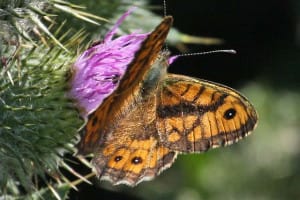The Guardian
by Patrick Barkham
 |
Source: Tony Morris |
Dramatic decline in population associated with increased use of controversial neonicotinoid chemicals on farms
Neonicotinoids may be contributing towards the disappearance of butterflies from the countryside, according to the first scientific study to examine the effect of the controversial agricultural pesticides on British butterflies.
Researchers found that 15 of 17 species which commonly live on farmland – including the small tortoiseshell, small skipper and wall butterfly – show declines associated with increasing neonic use.
Using population data from 1985 to 2012 gathered on more than 1,000 sitesacross the country, scientists at the universities of Stirling and Sussex, in partnership with Butterfly Conservation and the Centre for Ecology and Hydrology, found that neonicotinoid use better explained steep population declines than other factors.
Although the study cannot definitively identify the cause of the population drops, Martin Warren, chief executive of Butterfly Conservation, said that the correlation revealed by the research required urgent further investigation.
“The debate up until now has been focused on bees. If neonicotinoids are affecting a lot of other insects, we should be even more worried,” said Warren. “What we really want is more research. It’s crazy that we’re using a potentially dangerous-to-wildlife chemical and nobody has done those studies.
“If we’re going to get smart about using chemicals in the countryside we need to test them better before they get out there.”
Dr Andre Gilburn, of the University of Stirling, who led the butterfly study, said: “Our study not only identifies a worrying link between the use of neonicotinoids and declines in butterflies but also suggests that the strength of their impact on many species could be huge.”
Neonics were first introduced in 1994 and usage increased at its fastest rate during the first decade of the 21stcentury, when farmland butterflies also experienced a precipitous decline, despite a doubling in conservation spending and predictions that climate change would benefit most species.
The Essex skipper declined by 67% between 2000 and 2009 and the small skipper declined by 62% in the same period. Both species’ caterpillars live on grasses found on field margins. Other common farmland butterflies to have suffered steep declines include the small tortoiseshell (64%), the wall brown (37%) and the large skipper (35%).
According to the study, published in the journal PeerJ, these declines have largely occurred in England, where neonic usage is at its highest; in Scotland, where spraying of the pesticide is comparatively low, butterfly numbers are stable.
A US study published earlier this year found that dust emitted when seeds treated with neonicotinoids are planted causes sub-lethal effects in caterpillars of the monarch butterfly. Another study identified mobile dust containing a high concentration of neonicotinoids on the surface of fields, suggesting the pesticide could spread to effect insect populations which don’t live adjacent to arable fields. Matt Shardlow, chief executive of the charity Buglife, said: “Clearly the use of neonicotinoid seed treatments has been an unmitigated ecological disaster. It is such a shame that the government continues to support their use when the time has clearly come to extend the ban on seed treatments to cover all crops, not just oilseed rape.”
In 2013, the EU introduced a temporary ban on certain types of neonics for flowering crops such as oilseed rape to allow scientists to better determine the insecticides’ impact on bees. But neonics continue to be widely and legally used on other crops, particularly wheat.
Scientific studies have shown how neonics stay in the soil for years, leak into water and can be absorbed by wildflowers and grasses growing in field margins, which provide nectar for butterflies and food for their caterpillars.
Butterfly Conservation is launching a crowd-funding appeal for £6,000 to support a more detailed scientific assessment of the potential impact of neonicotinoids on farmland butterflies. The charity also wants scientists to test butterflies and their caterpillars to see if they have neonics in their bodies.
Researchers in the Netherlands have linked neonicotinoids found in surface water to declines in insectivorous birds and there is widespread scientific evidence that neonicotinoids harm bees – reducing their ability to pollinate plants, for instance. But scientists judge that there is still not enough data to say whether this harm ultimately leads to a decline in bee populations.
Dave Goulson, professor of biology at the University of Sussex, said: “Many of us can remember a time when our meadows and hedgerows had far more butterflies, bees and other insects than today. This study adds to the growing mountain of evidence that neonicotinoids are one of the causes of these declines.”

